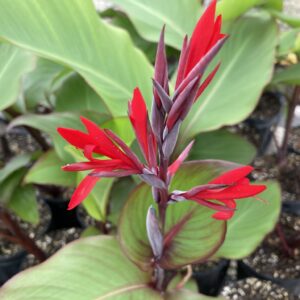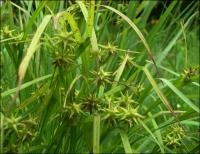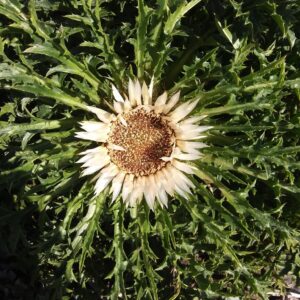Our Plants
Showing 113–120 of 587 results
-
Campanula poscharskyana Adriatic bellflower, Serbian bellflower Z 4-8
Riot of lilac colored star-shaped blooms May – June over this short, trailing mound of leaves.
Riot of lilac colored star-shaped blooms May – June over this short, trailing mound of leaves.
Size: 6" X 24" spreads
Care: Sun to part shade in moist well-drained soil.
Native: Mountains of Eastern Europe
Awards: Top rated by the Chicago Botanic Garden. Elisabeth Carey Miller Botanical Garden Great Plant PickCampanula is Latin meaning “little bell.” Collected before 1822. Named for 19th century German plantsman, Gustav Poscharsky.
-
Campanula rotundifolia Harebell, Bluebell of Scotland Z 3-8
Its delicate appearance conceals its hardy constitution. Dainty bluish-lilac bells to 12” stems on bushy round ground-hugging foliage. Blooms from June to October and occasionally November. Perfect for rock gardens and borders.
OUT OF STOCK
Its delicate appearance conceals its hardy constitution. Dainty bluish-lilac bells to 12” stems on bushy round ground-hugging foliage. Blooms from June to October and occasionally November. Perfect for rock gardens and borders.
Size: 9-12" x 12"
Care: Sun to part shade in moist well-drained soil
Native: Europe, Siberia and North America, including Wisconsin
Wildlife Value: Walnut and deer tolerantLakota ate the leaves raw and cooked and made an infusion of the roots to remedy earaches. Sir Walter Scott immortalized the Bluebell of Scotland in Lady of the Lake. Also a subject of Emily Dickinson’s poetry.
-
Campsis radicans Trumpet vine Z 5-9 VINE
Huge, gorgeous orange trumpets on vigorous vine
Mid-summer to early autumn – huge, gorgeous orange trumpets on vigorous vine
Size: 30’ x 3’ at base
Care: sun, moist well-drained soil. Prune in late winter or early spring by cutting back side shoots to within 2-3 buds of main stem
Native: PA to IL & south as far as Florida
Wildlife Value: magnet for hummingbirds, long-tongued bees, and Sphinx moths.In garden cultivation in America since early 1600’s. Collected in 1640’s by Tradescant the Younger (1608 – 1662), son of John Tradescant the elder. He went in person to Virginia between 1628-1637 (and possibly two more trips by 1662 to collect plants. When his father died, he succeeded as head gardener to King Charles I and Henrietta Maria from 1638 to 1642, when the queen fled England’s Civil War. Campsis is derived from the Greek word kampsis referring to the flower’s curved stamens. Radicans from radicant meaning “having rooted stems.” The bloom is “a most splendid sight,” according to Breck in 1851. Per Liberty Hyde Bailey in 1912: “The native trumpet creeper is very common in the southern woodlands and fields (with) a great variety in brilliancy of the blossoms. This is an excellent plant for covering the bare trunks of palmettos.” Pressed specimen in Emily Dickinson’s herbarium.
-
Canna edulis Indian shot, Arrowroot Z 7-10
Several shoots of red, tube-like flowers atop a tall stalk , taller than its banana plant-like, broad, waxy, oval foliage, green with purple toward the top. Flower all summer.
Several shoots of red, tube-like flowers atop a tall stalk , taller than its banana plant-like, broad, waxy, oval foliage, green with purple toward the top. Flower all summer.
Size: 8’ x 3’ spreading
Care: sun in moist to moist well-drained. In colder Zones, lift and overwinter indoors.
Native: Andes of South America, and the West Indies
Wildlife Value: attracts bees, hummingbirds and butterflies.
Size: Primarily grown as a root crop to eat, roast or boil root like a potato. Root is source of arrowroot used as thickener.Edulis means edible.
Carbon dating of tubers shown grown more than 3500 years ago.**LISTED AS OUT OF STOCK BECAUSE WE DO NOT SHIP THIS ITEM. IT IS AVAILABLE FOR PURCHASE AT OUR RETAIL LOCATION.
-
Carex comosa Longhair sedge, Bristly sedge Z 4-10
Ornamental dangling bottle brush spikes from May to August
OUT OF STOCK
Ornamental dangling bottle brush spikes from May to August
Size: 2-4’ x 2’
Care: Sun to part shade in wet to moist soil
Native: all of sub-Arctic No. America except western intermountain states and provinces and except Alaska.
Wildlife Value: food for caterpillars of several butterflies. Seeds provide food for wetland birdsRhizomes stabilize shorelines while plants give ducks cover and the seeds provide food. Good rain garden plant.
-
Carex grayi Gray’s Sedge Z 3-8
Cool club-like maces at the ends of stems- June to October
Cool club-like maces at the ends of stems- June to October
Size: 30" x 24"
Care: Full sun to part shade in moist or moist well-drained soil
Native: Vermont west to Wisconsin, south to Georgia and Missouri
Awards: Great Plants for Great Plains1st described in Vol VII of Transactions of Linnaean Society c. 1798. Botanists named and renamed it finally settling on Carex grayi to honor botanist Asa Gray (1810-1888).
-
Carex rosea Rosy sedge, Stellate sedge PERENNIAL GRASS Z 3-9
Mounds of thinnest of medium green leaves mingled with stems with star shaped seed clusters in May-June
OUT OF STOCK
Mounds of thinnest of medium green leaves mingled with stems with star shaped seed clusters in May-June.
Size: 12” x 10”
Care: part shade and shade in moist well-drained soil
Wildlife Value: No. Dakota south to TX & east incl. WI, New Brunswick and Nova Scotia.
Awards: Great Plants for the Great Plains Grass of the Year 2020Collected before 1811.
-
Carlina acaulis ssp. simplex Silver thistle, Weather thistle Z 3-9
Wide, white saucer flowers above silvery thistle foliage, open on dry days, closed in the evenings and on rainy days. July- September
OUT OF STOCK
Wide, white saucer flowers above silvery thistle foliage, open on dry days, closed in the evenings and on rainy days. July- September
Size: 6-12” x 12”
Care: sun in well-drained soil.
Native: Southern & Eastern Europe
Wildlife Value: attracts honey-beesThe Genus comes from Charles (Carolus). According to medieval folklore Charlemagne used this root to cure the ills of his troops.








